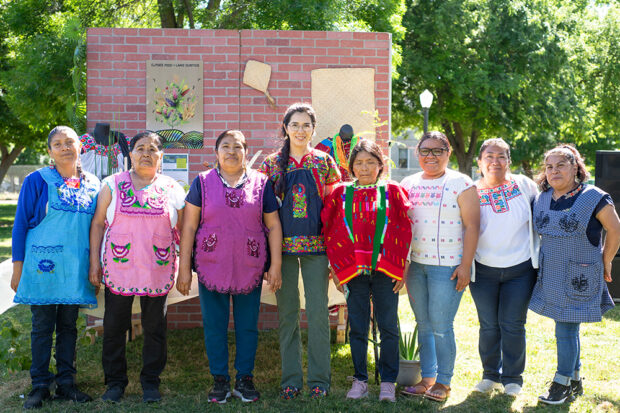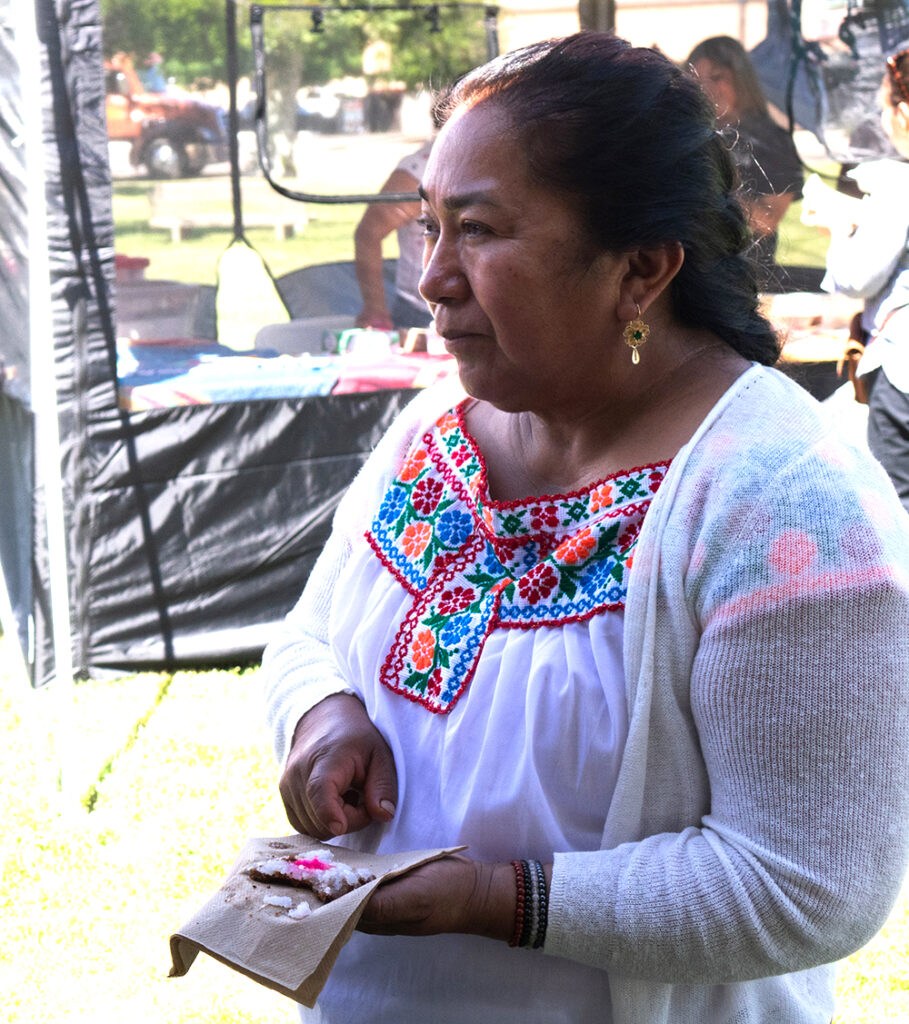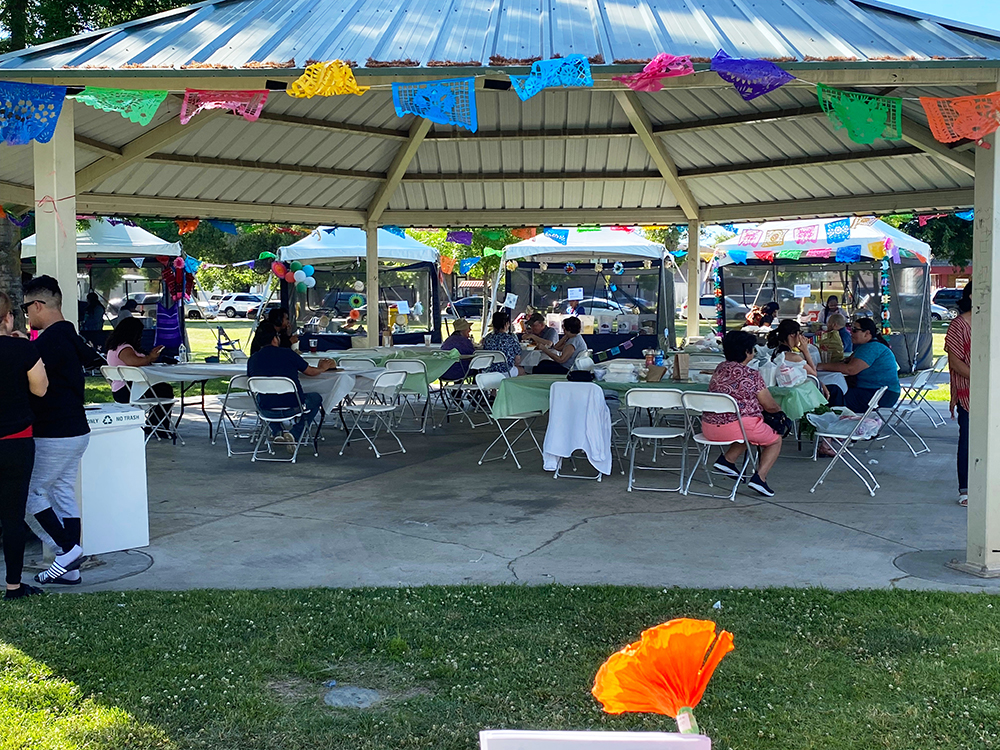
In the past 20 or so years, the cultural presence of Oaxaca in the San Joaquin Valley has become increasingly evident, particularly in Madera and Arvin (Kern County). Thousands of farmworkers have arrived to work in the Valley’s fields from Oaxaca, a southern state of Mexico with a large indigenous population. In Oaxaca, there are at least 16 different indigenous communities with their own languages and traditions.
One of those traditions is food. Oaxacan cuisine is not only delicious but also colorful, with a distinctive flavor in part due to the herbs used in it. In the past few years, we have seen a surge of Oaxacan cuisine at upper-scale restaurants on both sides of the border and many books and articles dedicated to that.

But as we all know, one thing is the food you can find in a restaurant and another thing is the food your mom makes. And that’s why a group of Oaxacan women in Madera—led by cultural organizer Rosa Hernandez—decided to create a traditional market in the park, with food, refreshments, freshly made tortillas, bread and desserts, and, of course, fresh farm produce. They called it Nu’u Yavi, which is marketplace in Mixteco, one of the indigenous languages spoken in Oaxaca.
“We invited women who we know cook keeping the traditional flavors, who like to keep the recipes of their mothers and grandmothers,” said Hernandez, a Mixteca from Santiago Juxtlahuaca, Oaxaca.
“The idea was to offer traditional dishes using the ingredients from our towns—if possible—while maintaining the atmosphere of our kitchens. And to introduce these dishes with pride, keeping our ancestral legacy.”
Nu’u Yavi took place on May 3 at the Court Park in downtown Madera. About one-third of the city’s 61,000 inhabitants are believed to be of Oaxacan origin. Madera also has the first city council member of Mixteco origin to be elected in the United States.
Seven Oaxacan women—six Mixtecas and one Triqui—cooked their favorite dishes and sold them to the public: tortillas, mole rojo and amarillo (red and yellow mole), pozole, fresh refreshments (or aguas), yiqui (a stew made of softened corn, avocado leaves and barbequed meat), tamales and huachimole (a dish made with tomatillos, guaje—the green pods of a tree—chile and pork meat).
The event was sponsored by the Pan Valley Institute of the American Friends Service Committee. The food stands were distributed as a semi-circle around the gazebo of the park, which became the center of the event. Many people attended, not only to eat but also to enjoy the conversation while children played around. There was soft Oaxacan music in the background.
“To me, [this] was an experience oriented to educate the public about our food and our cooking techniques,” said Daisy Mejia, who prepared huachimole.
“It’s like chile verde but it’s cooked with guaje seeds and chile costeño. My mom taught me how to cook it, so it means a lot to me. I hope our new generations don’t lose these recipes.”
How difficult is it to get the original ingredients? “Now, you can get guaje in some stores; that wasn’t the case a few years back,” explained Mejia. “Even guaje trees have been planted in the area.”
It’s not difficult to understand. Immigrants not only bring their working skills and energy but also reproduce their cultures—including, of course, their food.
So they create a market for new products that end up being planted locally. However, there are some exceptions. “Ideally, the huachimole is cooked with chile costeño (chile from the coast of Oaxaca). My mom brought them from Oaxaca because it’s not produced here,” said Mejia.

“What I liked from this event is that several women got together to cook and share our traditional food. It’s food we know, however, each one has a special touch they learned from their mothers,” said Mejia.
And, of course, there were tamales. The traditional types, and Oaxaqueños, which are made with banana leaves.
“When I cook, the smell, the colors, the flavors—they transport me to my homeland,” said Mireya Agustin, with a nostalgic tone. She offered tamales and pozole amarillo (pozole made with yellow chiles). “They are very popular during festivities celebrated at the plaza back home.”
These women have something in common when they cook for events like Nu’u Yavi. They have their families’ help.
Agustin mentioned that, although more Oaxacan ingredients are now produced here, “they don’t taste the same.”
She used to sell her food from home and at special events. “I like to share my food; people enjoy Oaxacan food and this makes me happy,” she said.
There is something else besides good food. “This effort—to organize the event—is part of a struggle, a struggle to get recognized as a community which is part of the community at large. This is also part of our contribution, we are not just working hands,” concluded Hernandez.
She suggested that participants are interested in repeating the experience in July.

